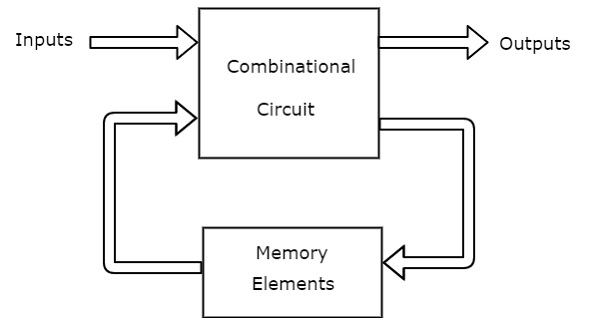Sequential Circuits
We discussed various combinational circuits in earlier chapters. All these circuits have a set of output, which depends only on the combination of present inputs. The following figure shows the block diagram of a sequential circuit.



This sequential circuit contains a set of inputs and output. The output of the sequential circuit depend not only on the combination of present inputs but also on the previous output. The previous output is nothing but the present state. Therefore, sequential circuits contain combinational circuits along with memory elements. Some sequential circuits may not contain combinational circuits, but only memory elements.
The following table shows the differences between combinational circuits and sequential circuits.
| Combinational Circuits | Sequential Circuits |
|---|---|
| Outputs depend only on present inputs. | Outputs depend on both present inputs and present state. |
| The feedback path is not present. | The feedback path is present. |
| Memory elements are not required. | Memory elements are required. |
| The clock signal is not required. | The clock signal is required. |
| Easy to design. | Difficult to design. |
Types of Sequential Circuits
Following are the two types of sequential circuits −
- Asynchronous sequential circuits
- Synchronous sequential circuits
Asynchronous sequential circuits
If some or all the outputs of a sequential circuit do not change with respect to the active transition of the clock signal, then that sequential circuit is called an Asynchronous sequential circuit. That means, all the outputs of asynchronous sequential circuits do not change effect at the same time. Therefore, most of the outputs of asynchronous sequential circuits are not synchronous with either only positive edges or only negative edges of the clock signals.

But these circuits are more difficult to design and their output is uncertain.
Synchronous sequential circuits
If all the outputs of a sequential circuit change respect to the active transition of the clock signal, then that sequential circuit is called a Synchronous sequential circuit. That means, all the outputs of synchronous sequential circuits change at the same time. Therefore, the outputs of synchronous sequential circuits are synchronous with either only positive edges or only negative edges of the clock signal.

We use sequential circuits to design Counters, Registers, RAM, MOORE/MEALY machines and other state retaining machines.


Comments
Post a Comment